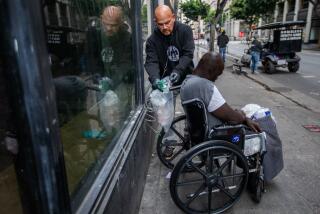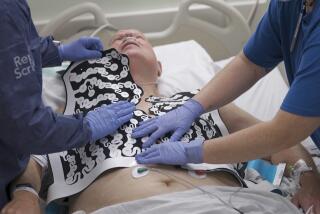A Step Past CPR--Training on Device That Restarts Heart
- Share via
MONTEREY — Heart doctors have begun training lay people for the first time to use electric shock devices that restart the heartbeat of some cardiac arrest victims. The development may make widely available a sophisticated technology that could save many lives.
If it can be shown in the next few years that lay people can easily learn to operate these portable, battery-powered devices, called automatic defibrillators, such machines may become a “new type of fire extinguisher in the general community,” said Dr. Richard O. Cummins of the University of Washington in Seattle.
Cardiopulmonary resuscitation “is what you do while you wait for the defibrillator,” he said Tuesday at the American Heart Assn.’s annual science writers forum here. CPR “buys you time by prolonging the process of dying, but it does not resuscitate people after a cardiac arrest.”
Cummins said defibrillators also might routinely be given to the families of heart patients who, upon hospital discharge, still are at high risk.
The automatic defibrillators, using electrodes attached to the chest, can analyze an unconscious patient for the presence of “ventricular fibrillation,” the most common reason for death following a heart attack.
If this rhythm is detected, a sudden jolt of electricity to restore the heartbeat is automatically delivered through the electrodes.
The devices, which are approved by the U.S. Food and Drug Administration for use by medical personnel, are designed not to fire if the patient has a normal heart rhythm. Typically, they take several minutes to set up and then can deliver up to three or four shocks over a one-minute period.
Already, family members, after receiving several hours of training, have successfully used the devices to save the lives of several patients who are part of an ongoing study at Seattle’s Harborview Medical Center, Cummins said.
In all, more than 200 lay people have been trained to use the devices.
The enthusiasm for automatic defibrillators reflects physicians’ growing realization that early application of electricity is the best known way to increase the survival rate of heart attack patients who would otherwise die before they reach a hospital, Cummins said.
Studies have shown that after the heart stops beating, the probability of survival declines about 7% a minute, even if CPR is administered immediately.
After 15 minutes, such a patient’s chances of surviving become virtually zero no matter what is done. It often takes paramedics or other trained professionals more than 10 minutes to reach a heart attack victim, even in cities like Seattle that have very efficient emergency-care systems.
In addition to studies involving family members of heart attack victims, the devices are being tested by large companies, such as Boeing Corp. and Weyerhaeuser Co., the giant timber firm, and by British Caledonian Airlines on its international flights.
About 1.5 million Americans suffer heart attacks each year and 540,000 die, about 350,000 before they reach the hospital. Only about 7,000 patients a year are resuscitated after cardiac arrest outside a hospital.






